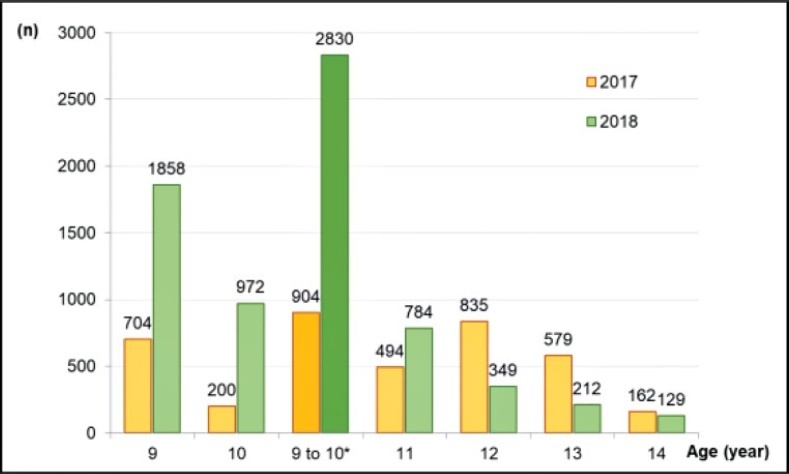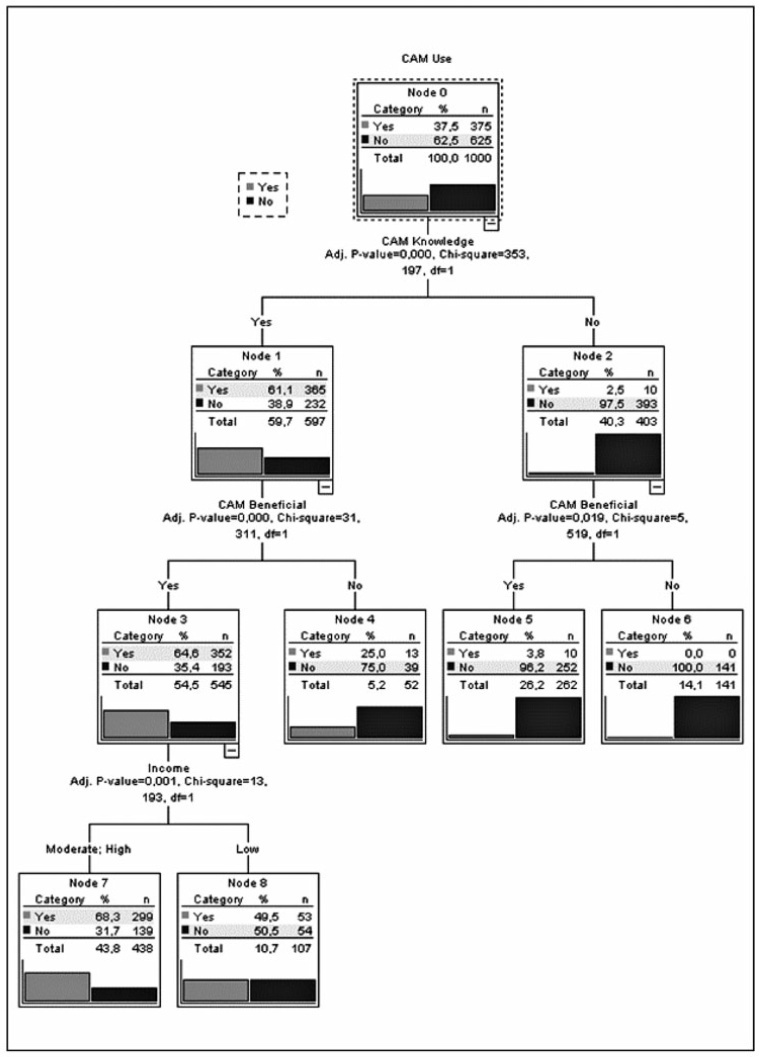-
Original Article01-24-2021
School-based HPV Vaccination: The Challenges in a Brazilian Initiative
Revista Brasileira de Ginecologia e Obstetrícia. 2021;43(12):926-931
Abstract
Original ArticleSchool-based HPV Vaccination: The Challenges in a Brazilian Initiative
Revista Brasileira de Ginecologia e Obstetrícia. 2021;43(12):926-931
Views316See moreAbstract
Objective
The present study assesses the implementation and the impact after 2 years of a school-based human papillomavirus (HPV) vaccination program in a Brazilian city.
Methods
A prospective study assessing the implementation of the program, offering quadrivalent HPV vaccine in two annual doses to girls and boys aged from 9 to 10 years old. The program was started in the city of Indaiatuba, state of São Paulo, Brazil, in 2018, and had authorization from the National Immunization Program. The number of HPV vaccine first doses applied and the coverage in 2018 was calculated and compared to the year 2017. There were described events that have influenced the results.
Results
The program invited 4,878 children through schools (87.1% of the target population), and 7.5% refused vaccination. Several concurrent events required or competed for health professionals of the vaccination teams. The coverage of the first dose (between 9 and 10 years old) was 16.1% in 2017 and increased to 50.5% in 2018 (p < 0.0001). The first dose in all ages increased 78% in 2018 compared with 2017 (6,636/3,733). Competing demands over the program continued in 2019, and the first dose coverage dropped (26.9%). For 2020, a municipal law instituted school-based vaccination and the creation of dedicated teams for vaccination, and these strategies are waiting to be tested.
Conclusion
School-based annual HPV vaccination in children between 9 and 10 years old was feasible and increased vaccination coverage, regardless of gender, although the program was vulnerable to competing events.

-
Original Article01-24-2021
Increased Risk for Maternal Anxiety during the COVID-19 Outbreak in Brazil among Pregnant Women without Comorbidities
Revista Brasileira de Ginecologia e Obstetrícia. 2021;43(12):932-939
Abstract
Original ArticleIncreased Risk for Maternal Anxiety during the COVID-19 Outbreak in Brazil among Pregnant Women without Comorbidities
Revista Brasileira de Ginecologia e Obstetrícia. 2021;43(12):932-939
Views192Abstract
Objective
To study maternal anxiety in pregnant women without comorbidities in the context of the COVID-19 outbreak in Brazil and to study maternal knowledge and concerns about the pandemic.
Methods
This is a secondary analysis from a national multicenter cross-sectional study performed in 10 cities, from June to August, 2020, in Brazil. Interviewed postpartum women, without medical or obstetrical comorbidities, were included in the present subanalysis. A structured questionnaire and the Beck Anxiety Inventory (BAI) were applied.
Results
Out of the 1,662 women, 763 (45.9%) met the criteria for the current analysis and 16.1% presented with moderate and 11.5% with severe maternal anxiety. Moderate or severe maternal anxiety was associated with high school education (odds ratio [OR]:1.58; 95% confidence interval [CI]:1.04–2.40). The protective factor was cohabiting with a partner (OR: 0.46; 95%CI: 0.29–0.73). There was a positive correlation between the total BAI score and receiving information about care in the pandemic (rpartial 0.15; p < 0.001); concern about vertical transmission of COVID-19 (rpartial 0.10; p = 0.01); receiving information about breastfeeding (rpartial 0.08; p = 0.03); concerns about prenatal care (rpartial 0.10; p = 0.01), and concerns about the baby contracting COVID-19 (rpartial 0.11; p = 0.004). The correlation was negative in the following aspects: self-confidence in protecting from COVID-19 (rpartial 0.08; p = 0.04), having learned (rpartial 0.09; p = 0.01) and self-confidence in breastfeeding (rpartial 0.22; p < 0.001) in the context of the pandemic.
Conclusion
The anxiety of pregnant women without medical or obstetrical comorbidities was associated to high school educational level and not living with a partner during the COVID-19 pandemic. Self-confidence in protecting against COVID-19 and knowledge about breastfeeding care during the pandemic reduced maternal anxiety.
Key-words Breastfeedingchildbirthcoronavirus disease 2019Maternal anxietypandemicPostpartumPregnancyQuestionnairesSee more -
Original Article01-24-2021
Use of androgens at different stages of life: reproductive period: Number 11 – December 2021
Revista Brasileira de Ginecologia e Obstetrícia. 2021;43(12):988-993
Abstract
Original ArticleUse of androgens at different stages of life: reproductive period: Number 11 – December 2021
Revista Brasileira de Ginecologia e Obstetrícia. 2021;43(12):988-993
-
Original Article01-12-2021
Complementary and Alternative Medicine Attitudes of Gynecologic Patients: Experience in a Tertiary Clinic
Revista Brasileira de Ginecologia e Obstetrícia. 2021;43(11):853-861
Abstract
Original ArticleComplementary and Alternative Medicine Attitudes of Gynecologic Patients: Experience in a Tertiary Clinic
Revista Brasileira de Ginecologia e Obstetrícia. 2021;43(11):853-861
Views172See moreAbstract
Objective
To evaluate the knowledge, attitudes, and behaviors regarding complementary and alternative medicine methods of patients who were admitted to gynecology outpatient clinics.
Methods
In the present survey, a questionnaire on complementary and alternative medicine practices was applied on 1,000 women (ages between 18 and 83 years old) who were admitted to the gynecology outpatient clinic of a tertiarymaternity hospital. Demographic features and knowledge, attitudes, and behaviors about these methods were inquired in face-to-face interviews.
Results
While 80.7% of the total participants thought that complementary and alternative medicine was beneficial, only 37.5% of them had used these methods previously. The rate of prior knowledge on this subject was of 59.7% and the source of information was physicians for 8.5% of the patients. However, 72.4% of all participants wanted to obtain information on these methods and 93.7% wanted to be informed by physicians. In the decision tree model, having knowledge about complementary and alternative medicine was the most effective factor determining its use (p<0.001). Phytotherapy was found to be the most used method, with 91.4%. The most preferred plant was onion (18.9%), and the most common reasons for herbal use were stress (15.4%) and fatigue (15.2%).
Conclusion
More than one-third of the patients who applied to the gynecology outpatient clinics used one of the complementary and alternativemedicine methods at least once. As gynecologists and obstetricians, we need to be more knowledgeable about these methods to provide correct guidance to our patients for accessing accurate and effective information.

-
Original Article01-12-2021
Association Between PON1 (L55M and Q192R) Genetic Polymorphism and Recurrent Pregnancy Loss in North Indian Women Exposed to Pesticides
Revista Brasileira de Ginecologia e Obstetrícia. 2021;43(11):805-810
Abstract
Original ArticleAssociation Between PON1 (L55M and Q192R) Genetic Polymorphism and Recurrent Pregnancy Loss in North Indian Women Exposed to Pesticides
Revista Brasileira de Ginecologia e Obstetrícia. 2021;43(11):805-810
Views250See moreAbstract
Objective
The aim of the present study was to examine the relation between the PON1 polymorphisms and recurrent pregnancy loss (RPL).
Methods
In a cross-sectional study, blood samples were collected from 100 females. DNA was extracted and PON1 genotypes were determined by polymerase chain reaction (PCR) amplification.
Results
Regarding PON1 L55M, the mutated allele (M) frequency was found in 70.5% in RPL and in 53.5% in controls; theMallele was significantly associated with an increased risk of RPL (adjusted odds ratio [ORadj]=2.07; 95% confidence interval [CI]; p<0.001). However, regarding PON1 Q192R, the R mutated allele frequency was found in 28.5% in RPL and in 33% in controls. The R allele did not show any risk for RPL (ORadj 0.81; 95%CI; p=0.329).
Conclusion
The present study suggests that there is an effect of genetic polymorphism on RPL and provides additional evidence that combines with the growing information about the ways in which certain PON1 genotypes can affect the development of the fetus in the uterus.
-
Original Article01-12-2021
Perinatal Outcomes and Factors Associated with Ethnic Group in cases of Preterm Birth: the Multicenter Study on Preterm Birth in Brazil
Revista Brasileira de Ginecologia e Obstetrícia. 2021;43(11):811-819
Abstract
Original ArticlePerinatal Outcomes and Factors Associated with Ethnic Group in cases of Preterm Birth: the Multicenter Study on Preterm Birth in Brazil
Revista Brasileira de Ginecologia e Obstetrícia. 2021;43(11):811-819
Views254See moreAbstract
Objective
To investigate the characteristics of women who had preterm birth (PTB) and related outcomes according to ethnicity.
Methods
A secondary analysis of a multicenter cross-sectional study conducted in Brazil. Women who had PTB were classified by self-report as white and non-white. Clinical, pregnancy, and maternal data were collected through postpartum interviews and reviews of medical charts. The sociodemographic, obstetric and clinical characteristics of the women, as well as the mode of delivery and the neonatal outcomes among different ethnic groups were compared through a bivariate analysis.
Results
Of the 4,150 women who had PTB, 2,317 (55.8%) were non-white, who were more likely: to be younger than 19 years of age (prevalence ratio [PR]: 1.05; 95% confidence interval [95%CI]: 1.01-1.09); to be without a partner; to live on low income; to have lower levels of schooling; to have ≥ 2 children; to perform strenuous work; to be fromthe Northeastern region of Brazil rather than the from Southern region; to have a history of ≥ 3 deliveries; to have an interpregnancy interval<12 months; to have pregnancy complications such as abortion, PTB, preterm premature rupture of membranes (pPROM), and low birth weight; to initiate antenatal care (ANC) visits in the second or third trimesters; to have have an inadequate number of ANC visits; to be under continuous overexertion; to smoke in the first and second or third trimesters; and to have anemia and gestational hypertension. The maternal and neonatal outcomes did not differ between the groups, except for the higher rate of low birth weight (73.7% versus 69.0%) in infants born to non-white women, and the higher rate of seizures (4.05% versus 6.29%) in infants born to white women.
Conclusion
Unfavorable conditions weremore common in non-whites than inwhites. Proper policies are required to decrease inequalities, especially in the context of prematurity, when women and their neonates have specific needs.
-
Original Article01-12-2021
Risk Factors Associated with Uterine Rupture and Dehiscence: A Cross-Sectional Canadian Study
Revista Brasileira de Ginecologia e Obstetrícia. 2021;43(11):820-825
Abstract
Original ArticleRisk Factors Associated with Uterine Rupture and Dehiscence: A Cross-Sectional Canadian Study
Revista Brasileira de Ginecologia e Obstetrícia. 2021;43(11):820-825
Views249See moreAbstract
Objective
To compare maternal and perinatal risk factors associated with complete uterine rupture and uterine dehiscence.
Methods
Cross-sectional study of patients with uterine rupture/dehiscence from January 1998 to December 2017 (30 years) admitted at the Labor and Delivery Unit of a tertiary teaching hospital in Canada.
Results
There were 174 (0.1%) cases of uterine disruption (29 ruptures and 145 cases of dehiscence) out of 169,356 deliveries. There were associations between dehiscence and multiparity (odds ratio [OR]: 3.2; p=0.02), elevated maternal body mass index (BMI; OR: 3.4; p=0.02), attempt of vaginal birth after a cesarian section (OR: 2.9; p=0.05) and 5-minute low Apgar score (OR: 5.9; p<0.001). Uterine rupture was associated with preterm deliveries (36.5 ± 4.9 versus 38.2 ± 2.9; p=0.006), postpartum hemorrhage (OR: 13.9; p<0.001), hysterectomy (OR: 23.0; p=0.002), and stillbirth (OR: 8.2; p<0.001). There were no associations between uterine rupture and maternal age, gestational age, onset of labor, spontaneous or artificial rupture of membranes, use of oxytocin, type of uterine incision, and birthweight.
Conclusion
This large cohort demonstrated that there are different risk factors associated with either uterine rupture or dehiscence. Uterine rupture still represents a great threat to fetal-maternal health and, differently from the common belief, uterine dehiscence can also compromise perinatal outcomes.


